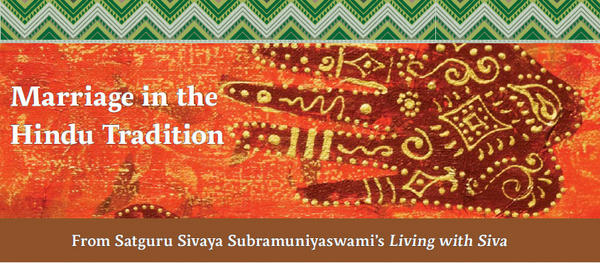
 ARRIAGE IS A UNION NOT ONLY OF A BOY AND GIRL, BUT OF their families as well. Not leaving such crucial matters to chance, all family members participate in finding the most suitable spouse for the son or daughter and thereafter commit hearts and minds to assist in times of need. Marriage is a sacred covenant which all relatives take up the responsibility to care for and protect. It is one of the most sacred events of life. Through the homa rite at the marriage ceremony, the priest invokes the Gods. The elders, the priests, the Gods, the devas, the planets and even cows witness the couple vow themselves to holy, harmonious matrimony for the rest of their lives. Thus, divorce or annulment are considered out of the question. The Rig Veda intones: “United your resolve, united your hearts, may your spirits be one, that you may long together dwell in unity and concord” (10.191.4).§
ARRIAGE IS A UNION NOT ONLY OF A BOY AND GIRL, BUT OF their families as well. Not leaving such crucial matters to chance, all family members participate in finding the most suitable spouse for the son or daughter and thereafter commit hearts and minds to assist in times of need. Marriage is a sacred covenant which all relatives take up the responsibility to care for and protect. It is one of the most sacred events of life. Through the homa rite at the marriage ceremony, the priest invokes the Gods. The elders, the priests, the Gods, the devas, the planets and even cows witness the couple vow themselves to holy, harmonious matrimony for the rest of their lives. Thus, divorce or annulment are considered out of the question. The Rig Veda intones: “United your resolve, united your hearts, may your spirits be one, that you may long together dwell in unity and concord” (10.191.4).§
While not all marriages must be arranged, there is wisdom in arranged marriages, which have always been an important part of Hindu culture. Their success lies in the families’ judgment to base the union on pragmatic matters which will outlast the sweetest infatuation and endure through the years. Compatibility of culture and education is also taken into consideration. A spouse is generally sought from within the same religious community. The man and woman should at least be of the same religious sect for long life and a happy marriage. This may not seem important if both are not religiously active, but conditions will tend to change in future years, especially after children are born, and the disparity can lead to separation and divorce. Most families begin early in finding the proper mate for their children among families they know and esteem for the kinship bonds the marriage would bring. Those involved ponder whether the two families can blend into a one family harmoniously with benefits to both. Stability is enhanced if the groom has completed his education, established earnings in a profession and is at least three years older than the bride.§
/////////////////////////////////////////////////////////////////
Siva’s followers arrange the marriages of their children, seeking sameness of lineage, astrological compatibility, harmony of the two families, total consent of both boy and girl and, foremost, their satguru’s blessings.
/////////////////////////////////////////////////////////////////§
Seeking the Best Match
In arranging a marriage, the families consult astrologers regularly until a match is found. Sometimes the boy and girl are allowed to get to know each other long before they are aware that a marriage is being arranged for them. Of course, if they do not get along well, the matter is dropped and the search is on again. If one match is not agreeable, another is sought. The inner-world devas also help to arrange the best matches. Most traditional astrologers have one or more devas assisting them to provide knowledge from the akashic records and insight into the planetary powers that impel karmas.§
Astrological compatibility is also sought for and acquired between the girl and her prospective mother-in-law. The results are taken especially seriously if they will be living in the same home, because in this case the bride will be under the guidance of the mother-in-law and may spend more time with her than with her own husband. In marrying the son, she becomes the daughter of his mother.§
Once a potential spouse is selected, discreet, informal inquiries are made by a relative or friend. If the response is encouraging, the girl’s father meets with and presents a proposal to the boy’s father. In some communities it is the boy’s father who presents the proposal. In these modern times, with the worldwide diaspora of Hindus from India and other countries, the fathers must take an aggressive role in helping their sons and daughters become well settled in life. If fathers do not fulfill this obligation, it becomes the duty of the mothers. This pattern differs from the tradition of well-settled village communities where only the father of the girl makes the overtures. In today’s widely dispersed global Hindu village, it becomes everyone’s duty to help in the task of matchmaking for the next generation.§
Once the union has been tentatively agreed upon, the families gather at the girl’s home to get further acquainted and allow them to meet and discuss their potential life together. Of course, mutual attraction and full consent of the couple are crucial. After all the input from the community is in place, it is the couple themselves who must make the final decision whether to spend their life together, based on their own personal sensibilities and judgments. They do have the right to say no. In recent years, we have found that an excellent way for a young prospective couple to gradually get to know each other before committing to marriage is through correspondence by e-mail over a period of several months. The first and the last important factor for a good match is that the boy and girl must be happy and comfortable in each other’s company.§
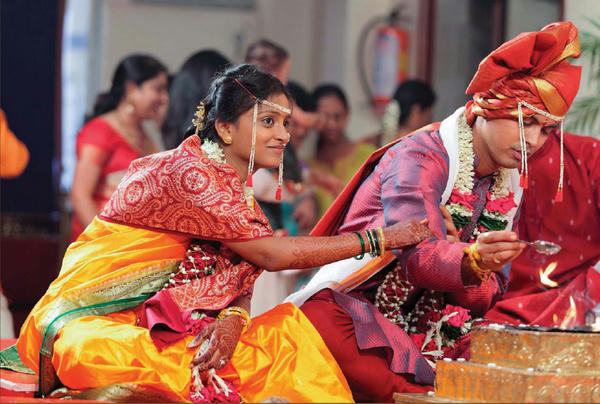
No offering is complete without the wife’s consent. The bride gently touches the arm of her groom as he offers ghee into the homa fire.
• • • • • • • • • • • • • • • • • • •§
Pledges and Blessings
Love marriages that are not arranged by the parents are also fully acceptable if the astrology is excellent, the parents on both sides agree and the young lady and the young man are of the same religious denomination. Of course, these ideals cannot always be met, and if not, more support will be needed from family and friends to make the marriage a success.§
Before the wedding, the bride and groom each writes out a covenant by hand, pledging loyalty to one another and formalizing their promises, ideals, expectations and love. The couple share and discuss these documents together, read them carefully and make necessary revisions until 100 percent agreement is achieved. Like a ship’s chart, these detailed vows can be referred to if the relationship gets off course. Each of the two families makes a written pledge as well, signed by the mother and father of the groom and the mother and father of the bride, stating what they promise to do and give toward supporting this marriage in the areas of artha, kama, dharma and moksha. Also most welcome are written testimonies in support of the marriage from grandfathers, grandmothers, uncles and aunts, sisters and brothers, as well as from other members of the religious community. This is also a time when anyone among family and friends may, in deepest confidence, even anonymously, share with the family preceptor any obstacles to this marriage that should be known and understood. A full, honest disclosure of the boy’s life and the girl’s life, including sexual experiences, should be made to both families and to the kulaguru.§
From the time of inquiry into a match, several months should be allowed for the jyotisha acharyas and shastris to assess compatibility. The whole process of arranging a proper match for a son or daughter often takes two or more years. There should never be a sense of urgency for this or any other lifetime commitment. As Jnanaguru Siva Yogaswami so wisely said, “No hurry. No worry. No sorry.” Nor should the arrangements ever be forced on the boy or girl. They remain free to cancel the process at any time if the match does not seem suitable to them.§
When all agreements have been reached, the boy’s mother adorns her new daughter with a gold necklace. Generous gifts are exchanged between the members of both families to bind the two families together in love and loyalty. Rejoicing begins with the formal engagement party, when the boy and girl exchange gifts, such as engagement rings. Later, they read their pledges to each other in the presence of elders. All arrangements and ceremonies culminate on the wedding day, when members of both families join to wish the couple a righteous, prosperous, happy life leading to the ultimate goal of enlightenment. During weddings or related ceremonies, the vegetarian diet should in no way be compromised. Meat and other nonvegetarian foods should not be served, even to please guests of other religions or communities. All Hindus attending should be requested to dress in formal Hindu attire.§
Supporting the Marriage
Once a marriage has occurred, both families are relied upon to hold it together through the years. It is the duty especially of the husband’s parents to support and make the marriage work and to offer a home to their new daughter. But it is unacceptable in modern Hindu society, and especially in our fellowship, to follow the oppressive tradition in which the girl becomes the total charge of the boy’s family and is seldom allowed to see her family of birth. It is the duty of the bride’s parents to monitor her protection and observe the couple’s abilities to dwell in unity and concord, while allowing them freedom to work things out together in their new home.§
If she is abused physically, they must open their doors to receive her back, to be sheltered, comforted and consoled. It then becomes their duty and that of all shishyas in the community to try to patch things up, restore harmony and obtain trustworthy promises from the husband that this will never happen again. The bride should receive no blame for her husband’s violence, for it is he who has broken his promise to adore her and protect her from harm.§
The blending of the two families as a one family gives both the son and daughter two families to support them in good times and bad. It is the responsibility of both families to work toward assuring an endearingly enduring marriage, as well as to guide the raising of the progeny, so that they may become good, productive, dharma-aware citizens, contributing to society at large. If the two families fail in this mutual effort, society fails.§
To build solid marriages, some Hindu institutions provide a family evening for fellowship and discussion with a trained counselor. Once a year during the holy time of Pancha Ganapati, the couple take out their marriage agreement and together study where they have been lax or derelict. They trace back in their minds to incidents that are still vibrating as negative samskaras, and apologize humbly and seek forgiveness and total resolution. They renew their commitment to each other. This is a wonderful key for setting the tone for the coming year—of harmony and peace, which leads to abundance and happiness. We call this anahata yoga, cleansing the heart chakra, bringing up that true love for one another. It is the process of bringing up all those things that were not settled before going to sleep, to retrieve those seeds before they get ploughed under and produce another crop of sorrow in the coming years. It is bringing up little things that each one said or did that hurt the other and were not resolved. It is bringing up incidents of anger, any physical violence, which should never be but may have been. It is time to extend apologies, talk with your kulaguru, and make promises and New Year’s resolutions to set the course of the future on the path of dharma, which is based on ahimsa.§
Cross-National Marriages
Many are the cross-national marriages happening today, marriages between members of different nations, religions, cultures or races. Times have changed. It is communication that has done it. With no communication, there is no change. When information flows freely, independent thinking is the result, and change is inevitable. Yes, inevitable, and that is what we are seeing today. The younger generation are thinking for themselves, no longer relying on elders to advise. This is unfortunate, for now they will have to learn from their own mistakes. What a way to learn! But this is what is happening, and it is happening faster than we would like to see. Much faster.§
Any kind of marriage can survive if true love is there as its glue. True love is the kind of love that gives the couple the ability to give and take from each other without serious conflict, to go through the ups and downs together in trust, to support each other without fail and to reign as benign king and queen strong enough to bind all members of the family together. Even the rishis said that when true love is there, any kind of astrology is good and the marriage will be lasting. Love overrides all bad influences and softens incompatibilities. Love is the sum of the law. But how would a young couple know if theirs is true love or magnetic love? By giving the love a test. That is how. Test it with time. Magnetic love weakens and all but disappears over time. True love grows stronger, much stronger, with time. True love mellows through the years.§
Cross-national marriages are essential to the Hindu thought that avant-garde thinkers are sharing today, “All the world is one family,” Vasudhaiva kutumbakam. Citizens of the world bound in love can survive the torrents of the upheavals that naturally come as lives are lived through together and individuals grow ever closer and closer in body, mind and spirit.§
Every marriage needs a support of some kind or another built into it. True love is the best support of all, but support from the parents on both sides is a necessary help, too, especially for couples who were drawn together only by magnetism. It is when the magnetic love fades away, and all that’s left are the children, that support from parents and friends is essential for the marriage to last without violent outbursts of released stress which was once undying passion.§
Shall we have a look into the future? Since cross-national marriages have happened, are happening, and will continue to happen, there must be some sensible way for them to happen without undue strain on the families of the couple. Wisdom is supposed to fix things, heal conditions and settle problems. But first we have to admit that there is a problem. And, yes, cross-national marriages are a problem to many people of the old school. The old school only became old just ten years ago. Before then it was a school sharing standards of how things should be to maintain a growing and stable society.§
Eight Points of Traditional Matchmaking
 E BRIEFLY EXPLORE THE VENERABLE HINDU SYSTEM BY which parents find a suitable partner for their eligible boy or girl, taking into account family backgrounds, personal characteristics, astrological compatibility and mutual consent of the couple-to-be. Until the last few centuries, marriages in all human cultures were arranged. Kindred were closer, and in very real ways a new bride or groom became daughter and son, joining the extended family. Such arrangement provide community stability and strength, and a wisdom derived from making this crucial decision based on life-long knowledge of the couple.§
E BRIEFLY EXPLORE THE VENERABLE HINDU SYSTEM BY which parents find a suitable partner for their eligible boy or girl, taking into account family backgrounds, personal characteristics, astrological compatibility and mutual consent of the couple-to-be. Until the last few centuries, marriages in all human cultures were arranged. Kindred were closer, and in very real ways a new bride or groom became daughter and son, joining the extended family. Such arrangement provide community stability and strength, and a wisdom derived from making this crucial decision based on life-long knowledge of the couple.§
According to the 2,400-year-old Hindu law book, Artha Shastra, “Any kind of marriage is approvable, provided it pleases all those that are concerned in it.” Of the eight forms described in this and the other ancient law books, the first four—brahma, daiva, arsha and prajapatya—involve some form of arrangement, without dowry, between the parents of the boy and girl. These four are termed prashasta or “commendable.” The brahma form is the free giving of a girl “well adorned” with jewelry and clothes to a boy of good character. The daiva form is the bestowal of a girl to the officiating priest at a sacred ceremony; the arsha form is bequeathing of the girl signified by the auspicious gifting of two cows to her family. In the prajapatya form the bride is given with the condition that the couple perform their religious duties together. The remaining, aprassasta or “not praised,” forms are: asura, the giving of a maiden in return for payment from the suitor; gandharva, the voluntary union of a couple arising from passion; rakshasha, the forcible abduction of a maiden; and paichacha, the stealing of a girl when she is drugged or asleep.§
Hindu law accepts the gandharva marriage, condemns the asura and paichacha forms and limits the rakshasha to the warrior caste, Lord Krishna’s abduction of Rukmini being a famous example. However, any marriage can be legitimized upon the consent of the girl and her parents.§
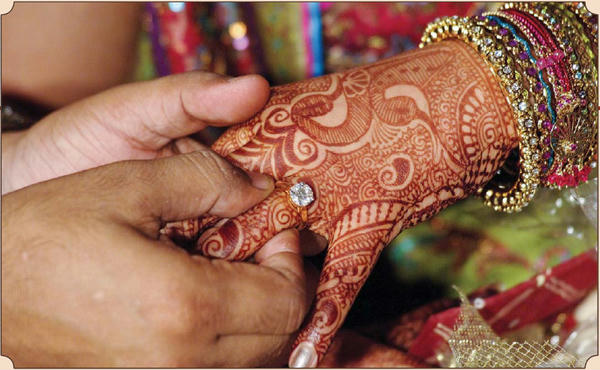
Of the many gifts she receives from her husband, two are most significant for the bride: the ring and the chain. Both are symbols of commitment made for a lifetime together, even seven.
• • • • • • • • • • • • • • • • • • •§
When It’s Too Late to Say No
When an Asian girl marries a black boy, should she be banished from the kingdom? Yes, according to the old school, the old standard. No, according to the new school, the new standard. The banishment method of parental punishment is outdated and bizarre today. Today’s girls think. They understand. They do not intend to be the ill-treated servants of the mother-in-law. The days of Cinderella have long since passed when the mean old stepmother made her cringe beneath her wrath. Boys, too, think for themselves. They read, they listen and evaluate. Theirs is an ever-changing world ahead. They are busy preparing for it. But then along comes love, of one kind or another, to complicate their lives.§

Catch them young, they say! When they marry young and grow together, they stay good friends forever.
• • • • • • • • • • • • • • • • • • •§
When Karen falls in love with Shan and elopes to his country, go visit them and bring her home in your heart. “I love you, therefore, I love whom you love.” That should be the attitude. When Kumar announces his undying love for Carmen, his lover from Mexico, and informs you that her father has a place for him as senior partner in his business, accept it. Enjoy Mexico City. It is a great place, because Kumar and Carmen are there.§
Yes, hands across the ocean are loving hands. Hands across the ocean are binding continents to continents, businesses to businesses. This and more is what all Hindu elders are seeing happening around them today. Today’s world is a happening world. Cross-national marriages are inevitable as the peoples of the world become more and more a global village. This is the real, earthy expression of our belief in one God and one world. The soul has nothing to do with nationalism, social restrictions, ethnic taboos or restrictive, prejudicial upbringing. Two souls joining in dharmic matrimony transcend all such boundaries.§
My advice has always been that families should arrange marriages for their children. That’s part of their purusha and stri dharma. This is a process they should begin early on. But if they don’t do that, obviously their young people will start arranging their own marriages. And very often when they do arrange a marriage for themselves, the family objects. They have no right to object, because they didn’t perform their duty in the first place.§
The dilemma is that matches are not being arranged, and yet parents also want strict control over their youth, and youths are going to find partners, one way or another. Girls especially should be chaperoned. It’s very easy in today’s world to meet the wrong kind of people. As one solution, though not the ideal, I recommend in such cases that mature young ladies double-date and chaperone each other. Then they can talk together about the young men they are dating, and bypass the families who’ve neglected their duties, and arrange a good marriage for themselves that will be lasting, and in the future raise the next generation by doing their duty by arranging a marriage according to tradition for their own children early on.§
We cannot stand in front of progress, lest we get run over by it. But we can sit by the side of progress and guide it so it doesn’t run off the track. This cannot be done when we break off communications and refuse to talk to the youth when they don’t obey the old standard. It is communication that is catalyzing the changes in the first place, so we all must guide the young by keeping the channels of communication open. Don’t let them go. Go with them. Love them and gently guide them.§
1. How It Begins
 PON THE BOY’S COMPLETION OF EDUCATION AND BEGINNING OF GAINFUL employment his parents proceed in earnest to find him a bride. As with most of the customs regarding arranged marriage, this practice remains virtually unchanged from Vedic times, when the boy was married at age 24 upon conclusion of the brahmacharya ashrama, or period of studentship. The girl is expected to be three or four years younger than the boy, due to the girl’s faster maturity. Ideally girls are married between 17 and 21, boys from 21 to 28—older being less of a problem for a boy than a girl. The “word” is put out through friends, relatives and most recently matrimonial ads. Also the children may be asked if they already have someone in mind. Sometimes a match is found very quickly, in just a week or two. In other cases it may take six months to a year to locate a suitable prospect. A go-between (termed aryaman in ancient times) is essential to the process. He may be an uncle, other close male relative or, in some areas, the village barber. The men make the contacts, but they do nothing without full consultation and agreement from the women of the family. Once the go-between has determined both families are favorably disposed to a match, a formal preliminary proposal is made by the girl’s father to the boy’s father.§
PON THE BOY’S COMPLETION OF EDUCATION AND BEGINNING OF GAINFUL employment his parents proceed in earnest to find him a bride. As with most of the customs regarding arranged marriage, this practice remains virtually unchanged from Vedic times, when the boy was married at age 24 upon conclusion of the brahmacharya ashrama, or period of studentship. The girl is expected to be three or four years younger than the boy, due to the girl’s faster maturity. Ideally girls are married between 17 and 21, boys from 21 to 28—older being less of a problem for a boy than a girl. The “word” is put out through friends, relatives and most recently matrimonial ads. Also the children may be asked if they already have someone in mind. Sometimes a match is found very quickly, in just a week or two. In other cases it may take six months to a year to locate a suitable prospect. A go-between (termed aryaman in ancient times) is essential to the process. He may be an uncle, other close male relative or, in some areas, the village barber. The men make the contacts, but they do nothing without full consultation and agreement from the women of the family. Once the go-between has determined both families are favorably disposed to a match, a formal preliminary proposal is made by the girl’s father to the boy’s father.§
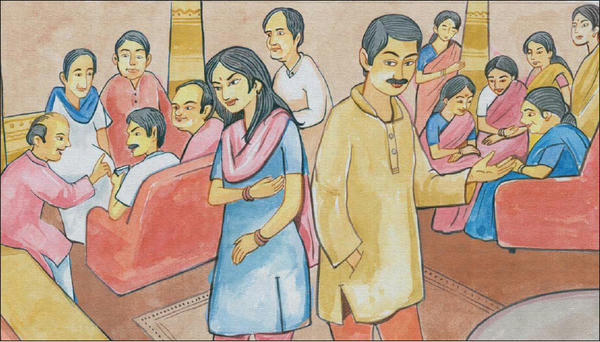
RAJEEV N.T.§
At a common function, elders in the family discuss and debate possibilities for their children. A young girl and a slightly older boy stand aside, conscious they are being talked about.
• • • • • • • • • • • • • • • • • • •§
Interfaith Marriages
I tell young ladies, if you are planning on getting married, do not do what the average mother might tell you, “Get the husband under your thumb right at the beginning. Otherwise you might have a terrible time, because it’s harder to do it later on.” Don’t do that. Go into your marriage for better or for worse and live up to your vow. Be to your husband like melted butter is on toast; it is absorbed. Be one. You will have a very happy old age.§
It might be rough at the start, but don’t hold divorce over his head to force him into various preconceived ideas that your girlfriend has put into your mind, as so many do, or that you’ve seen on television or in the movies. You have seen the results that Hollywood marriages have played upon the lives of those who have had them as they have gotten older through the years. They are not happy people, though they are advertised as glamorously as they make their living. That is not the way. The way is, when you take your vow, think about it first, and then stick to it for better or for worse.§
I tell young men, “Gentlemen, if you are thinking about getting married, do not marry a young lady who won’t be one with you in your religion, who will not be willing to stay at home and take care of and raise your family, one who doesn’t respect you as a man and starts, right off the bat, by telling you what to do. Don’t do that, because if you do you will be miserable and you will lose your manhood and be nothing but a puppet on the strings of your wife. And you will both be unhappy, but she especially, in older age. Rather, choose a girl who will blend with you for better or for worse. And whether you are successful or not, she will be happy to eat what you eat and go where you go. A Roman ideal pronounced by the bride at weddings was ‘Where you are, there I will be.’ It might be difficult in the beginning years, but it will be much better later.”§

Warmth and security are two gifts the young couple offer to each other, each in their own way. He is strong and paves the way, while she gently supports and suggests.
• • • • • • • • • • • • • • • • • • •§
A seeker wrote to me saying, “I’m in love with a Christian girl but she wants me to give up my religion and accept Jesus Christ. How can I explain to her that Hinduism is my path and I want to stay with it, but I love her very much? What should I do, Gurudeva?” I responded that you have to think of the children and how you want to raise them. Obviously you want to raise them to be good Hindu children. Since there is very little connection between Hinduism and Christianity—because Christianity does not accept karma or reincarnation, the existence of an all-pervasive God or our temples and ceremonies—there will be serious problems. If she remains a Christian and you remain a Hindu, the children are going to be very confused. If your beloved doesn’t want to go along with you intellectually and spiritually, maybe your love is only physical; that is called carnal love—love of the flesh. That is a very limited type of love, and it is not long lasting. Don’t be guided by your carnal, instinctive emotions. Be guided by your spiritual intellect, or by my good advice. Go shopping. Find a good Hindu girl, or let your parents find one for you, so you can raise a good new generation of high souls.§
I’ve seen many cases of Hindus marrying outside of their own religion, and I’ve seen the young couple be very happy for a while. But after the children come and the sensuality of the marriage has cooled off, then there arises a tension between the husband and wife. Generally one becomes more religious than the other. The non-Hindu spouse argues, “You should be religious in my religion,” and the Hindu insists, “You should be religious in my religion.” The victims of this conflict, which generally goes on throughout life, are the children. It is a couple’s shared allegiance to a religious tradition that is the most important common ground.§
2. Family Background
 HINDU MARRIAGE JOINS NOT ONLY TWO INDIVIDUALS, but two entire extended families, numbering dozens, even hundreds, of people. The reputation, learning, religious life and allegiance, health, personal traits, refinement and customs of those families contribute to the potential success of a marriage as much or more so than the individual qualities of the boy and girl. What is sought for is sameness of family background and economic and social status so that when the girl joins the boy’s family, she does not enter a home greatly different from her own. Non-smoking, non-drinking and vegetarianism may be essential, required conditions. The matchmaking investigation is done openly by talking with friends, relatives and fellow employees of the concerned families, all of whom readily share information. In the present day, sameness of family often still means marrying within one’s caste. But the mixed nature of modern society have the effect that caste does not insure the similarity of background it once did, particularly if the boy is raised in one country and the girl in another. A mandatory check of family lineage guarantees observance of the often complex local customs regarding degrees of permissible blood relationship.§
HINDU MARRIAGE JOINS NOT ONLY TWO INDIVIDUALS, but two entire extended families, numbering dozens, even hundreds, of people. The reputation, learning, religious life and allegiance, health, personal traits, refinement and customs of those families contribute to the potential success of a marriage as much or more so than the individual qualities of the boy and girl. What is sought for is sameness of family background and economic and social status so that when the girl joins the boy’s family, she does not enter a home greatly different from her own. Non-smoking, non-drinking and vegetarianism may be essential, required conditions. The matchmaking investigation is done openly by talking with friends, relatives and fellow employees of the concerned families, all of whom readily share information. In the present day, sameness of family often still means marrying within one’s caste. But the mixed nature of modern society have the effect that caste does not insure the similarity of background it once did, particularly if the boy is raised in one country and the girl in another. A mandatory check of family lineage guarantees observance of the often complex local customs regarding degrees of permissible blood relationship.§
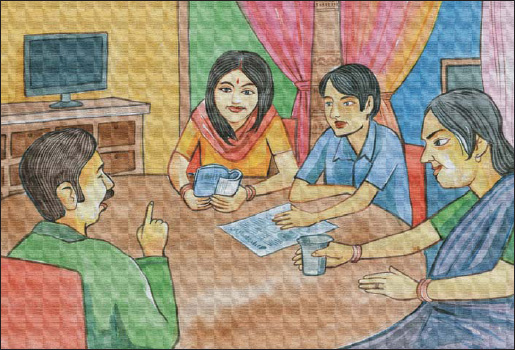
RAJEEV N.T.§
The father brings to the table all that he has gleaned about the boy’s family from his friends. The mother adds what she has learned from her circle and voices her concerns on a point or two.
• • • • • • • • • • • • • • • • • • •§